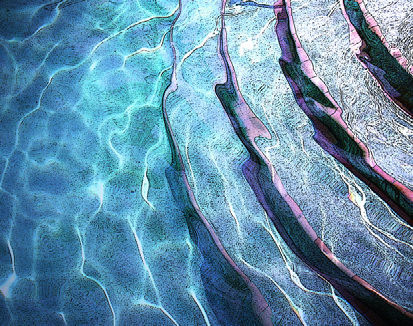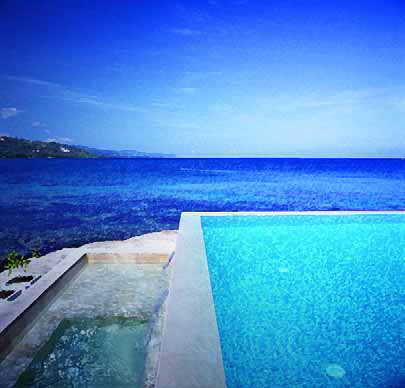engineering
Sometimes you just know that a client is going to want something special - something nobody else has. I can think of no other entity that better fills that bill than the Walt Disney Co. Justly famed for its remarkable creativity, spirit of innovation and ultra-high standards for design and execution, I knew going in that working with this amazing organization would mean coming to the table with strong ideas, supreme self-confidence and a demonstrated willingness to test boundaries and perform beyond expectations. Our firm, Captured Sea of Sunset Beach, Calif., was founded with those exact qualities in mind and a mission to create fountain systems throughout southern California that are distinctive, unique in concept, superbly engineered and built to last. Through the past eight years, we've been fortunate to tackle several projects for Disney in southern California. In each case, they were looking for watershapes that would delight visitors while enduring the rigors of heavy-duty use and near-constant operation. The call about the fountain featured in this article came in late summer 1999 from Glendale, Calif.-based Walt Disney Imagineering (WDI), the remarkable division of the company responsible for designing its theme parks and attractions. They told us that they were
Sometimes you just know that a client is going to want something special - something nobody else has. I can think of no other entity that better fills that bill than the Walt Disney Co. Justly famed for its remarkable creativity, spirit of innovation and ultra-high standards for design and execution, I knew going in that working with this amazing organization would mean coming to the table with strong ideas, supreme self-confidence and a demonstrated willingness to test boundaries and perform beyond expectations. Our firm, Captured Sea of Sunset Beach, Calif., was founded with those exact qualities in mind and a mission to create fountain systems throughout southern California that are distinctive, unique in concept, superbly engineered and built to last. Through the past eight years, we've been fortunate to tackle several projects for Disney in southern California. In each case, they were looking for watershapes that would delight visitors while enduring the rigors of heavy-duty use and near-constant operation. The call about the fountain featured in this article came in late summer 1999 from Glendale, Calif.-based Walt Disney Imagineering (WDI), the remarkable division of the company responsible for designing its theme parks and attractions. They told us that they were
As milestones go, the project depicted in these pages has been a big one for me - and for lots of other people as well. The grand estate with its outsized home is located in the countryside near Hanover, Pa., a remote setting that offered a set of challenges that has in many ways redefined what is and isn't possible in a whole region when it comes to watershape design, engineering and construction. A full two-and-a-half years in the making (a period broken up, of course, by stretches in which there was no activity on site), this stands as one of
In a couple of my recent "Details," I've discussed the early stages of a wonderful project located on the waterfront of Long Beach Island, N.J. As is the case with many top-level jobs, this one required a great deal of work in the early going to make sure we were set up for complete success once the installation process was under way and the pool, spa and surrounding structures began to come together. Although the pool in question is a simple rectangle designed to function mainly as a subtle and elegant reflective surface, there are certain features within the "shape" of the shell that make it something special - and particularly relevant to how the clients
It's easy to talk about watershapes and the creative and business philosophies that drive success, but to borrow a phrase: The proof is in the pool. In other words, it's one thing to talk about doing a good job, but it's another to step up and do it. The dynamics of that success are unusually complex when you participate in a project as the member of a team. As a case in point, I'll return to a semi-public watershape I first mentioned in my March 2006 column: It's now complete and is one of which I'm particularly proud. Located in Jamaica near Montego Bay at a property known as the Round Hill Hotel & Villas, it was a special sort of commercial project in that, being built outside the United States, it wasn't subject to
Sometimes the simple things make all the difference between success and failure. For all of the high-flown conceptualizing that drives much of what so many watershapers do these days, there's no escaping the need for attention to
The goal of a landscape design is to complement a beautifully appointed home with hardscape, plants and other outdoor amenities. Once construction begins, however, reality sets in for many clients and they begin making trade-offs to trim costs and manage the project's bottom line. Most often, cuts like these take their toll on project elements that swing into place toward the end of a project, where the most significant costs tend to be related to larger plants and landscape lighting. Smaller plants can
In most projects, great work requires the watershaper's personal understanding of who the clients really are, deep down. That doesn't mean we have to become our clients' best friends or marry into their families. Rather, creating watershapes at the highest level involves a different kind of relationship, one in which a shared vocabulary and common vision develop through discussions of water, stone, art, plants and the orchestration and staging of experiences that will occur in given spaces. Take the project covered here as an example: The scope of the work, an unlimited budget and a mandate for the highest possible levels of quality were enough on their own to force us to explore the limits of our skills and creativity. More important from our perspective, however, is that we
I may be revealing a professional bias here, but ozone is fascinating stuff. In nature, it's among the most essential chemicals on the planet, existing most prominently as a gaseous component of our upper atmosphere. Formed there by sunlight's reaction with atmospheric oxygen, it collectively constitutes the famous Ozone Layer that protects us from the sun's ultraviolet rays and is crucial to the very existence of life on earth. Closer to the ground, ozone is widely used across a broad spectrum of applications. It's well known in the pool and spa market as a water sanitizer, for example, either as a chlorine alternative or an adjunct. It's also widely used in food processing and municipal drinking and wastewater treatment systems and plays key roles in the production of cosmetics and with air freshening and purification systems. For all that, one of the most interesting applications of ozone-generating systems in the past 20 years - and the subject of this article - is the use of ozone in the life-support systems for aquatic animals held in captivity or for
Think about what happens when rainwater falls on an impervious surface in a big outdoor parking lot studded by the occasional tree: The water dampens the surface, which instantly becomes saturated. Only a minute percentage of water that penetrates the trees' canopies to reach their curb-bound planters becomes available to the trees' roots. The rest almost immediately starts flowing to drain grates or perimeter drainage details and is lost to a stormwater-collection system. The trees are helped only marginally by the life-giving rain, and the water





















